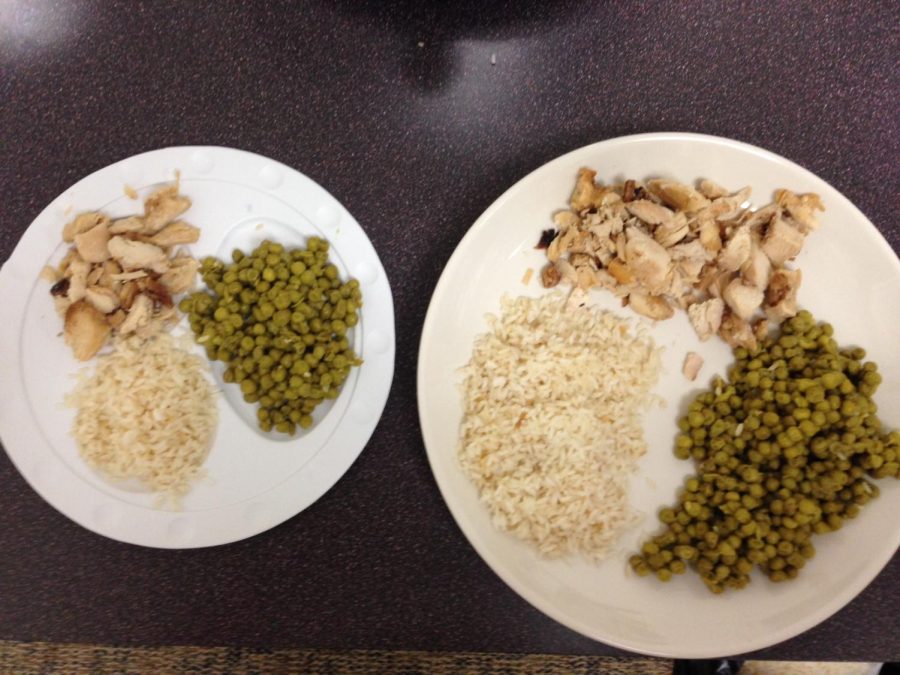Studies rely on optical illusions to overcome obesity
September 22, 2017
Kent State researchers studying optical illusions have created a plate prototype to combat obesity.
After conducting five different studies since 2015, the one study they hope to publish looks at how people are unconsciously conditioned to portion themselves based on their plate size.
Joel Hughes, a psychology professor at Kent State and leader of the studies, said he and his team of students got a design patent for the plate prototype they created.
“Little environmental changes actually can help you,” Hughes said. “Portion sizes have gotten huge because the environment changed. So, we said: Let’s make them smaller just by giving you a plate that makes it obvious what to do.”
The plate uses two types of optical illusions. The Ebbinghaus illusion gives the impression that something is larger and smaller compared to the shapes around it, and the Delboeuf illusion skews the perception of an object’s size because of the distance from its border.
Both illusions combined make food look bigger and may help people lose weight over time.
Hughes took inspiration for his study from a similar study done by Brian Wansink, the director of the Cornell University Food and Brand Lab, who tested the impact of bowl size.
As part of Wansink’s study, he gave a 90-minute presentation to a group of people on his findings and sent them home. Two months later, he invited the group to a party split into two rooms; one room had gallon-sized bowls of Chex Mix and the other had half-gallon sized bowls.
“If they were serving out of gallon bowls, (they) took 53 percent more Chex Mix,” Wansink said.
Fifty-three percent is equal to 270 calories. Over a year, if people consumed an extra 270 calories per day, they would gain about 27 pounds.
Taking from Cornell’s study, Hughes said he hopes to make his prototype commercially available. This product will be geared toward middle-aged people about 45 years old who are struggling to lose weight.
“I can’t override people’s behavior, but I just want to shape it with an environment that’s not as bad,” Hughes said. “One of the big hypotheses is that the food environment has gotten a lot worse.”
The Department of Agriculture has taken steps to combat this same issue by creating MyPlate, which is a reminder to find your healthy eating style and build it throughout your lifetime.
While the USDA is focusing on a younger generation, Hughes remains focused on people in his own demographic. He hopes to run another test on people who are middle-aged or with someone on campus who has a food laboratory where they can accurately determine how much food was taken from a buffet from scales beneath the plates.
John Gunstad, a psychology professor and the director of the Applied Psychology Center, was part of the team conducting the study, and said the real goal of the research was to help people get and stay healthy.
“Dieting is hard and we were interested in looking for new ways to help people lose weight,” Gunstad said. “Past research shows that many people ‘eat with their eyes,’ so we thought that building an optical illusion into a plate might make it easier to select healthy portion sizes.”
Hughes said he has no desire for capital gain from these plates. He has reached out to the business start-up TV show Shark Tank, and received a call back saying the show had no desire in the licensing. If someone would license the plates, Hughes would let them manufacture them. He would rather be the one who tests whether or not it works.
“This is kind of a side project, this is not what I do most of the time,” Hughes said “But it’s too fun not to do it. Eventually we’ll get there. It’s been a long time but I’m relentless and persistent. I think the future of dieting is going to include some of these environment changes.”
Dylan Thacker is the recreation and fitness reporter. Contact him at [email protected].












